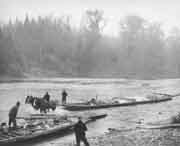Historical Vignettes
Working in the Forest: a Strenuous Routine
The opening of the lumber camps also coincides with the arrival of French-Canadian immigrants around 1826 and 1827. The first loggers to settle in the areas of Upper-Madawaska, New Brunswick, and Aroostook, Maine, would be squatters who built cabins along the Saint John River. They cut wood, which would later be brought down to the rivers. A few Acadian colonists also cut wood, enough to make ends meet and sometimes even more. The beginning of the 19th Century thus marks a new era, that of the forest industry, which will change the history of Madawaska forever.5
Madawaskayans prove to be more than decent workers both on the fields and in lumber camps, which greatly pleases the forest operators. The wood industry provided an opportunity for most families settled on the smallest farms to make ends meet, without making it possible for them, however, to raise their standard of living. As for the more affluent farmers, they had no choice but to capitulate their position to the nouveaux riches, the forest contractors, plant managers and merchants. 6
The lumber campsThe opening of lumber camps provides new workplaces as well as new working conditions for the inhabitants of Madawaska. Lumberjacks and log drivers, leave behind their families and farm work at the beginning of the winter to go up to the logging sites to return home only in spring. Back then, snow and water were the foundations of the transportation system for the forest industry, because of the absence of railways and roads.7

